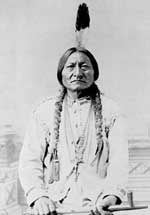Origin: Sioux
+Add origin to My Preferences

The Sioux are Native American and First Nations people in North America. The term can refer to any ethnic group within the Great Sioux Nation or any of the nation's many language dialects. The Sioux comprise three major divisions based on Siouan dialect and subculture:
Santee
Officially known as Isáŋyathi or Isáŋathi ("Knife," originating from the name of a lake in present-day Minnesota). Residing in the extreme east of the Dakotas, Minnesota and northern Iowa, and are often referred to as the Santee or Eastern Dakota
Yankton
Officially known as Iháŋktȟuŋwaŋ and Iháŋktȟuŋwaŋna ("Village-at-the-end" and "little village-at-the-end"). Residing in the Minnesota River area, they are considered to be the middle Sioux, and are often referred to as the Yankton and the Yanktonai, or, collectively, as the Wičhíyena (endonym) or the Western Dakota (and have been erroneously classified as "Nakota").
Lakota
Thítȟuŋwaŋ or Teton (uncertain, perhaps "Dwellers on the Prairie"; this name is archaic among the natives, who prefer to call themselves Lakȟóta). The westernmost Sioux, known for their hunting and warrior culture, are often referred to as the Lakota. The Lakota Way of Life is a visual representation of Pte Oyate – the Buffalo Nation. For many Plains Tribes, the buffalo sustained all life. Every part of the animal was used – the meat for food, and the hides for robes, tepee covers and shields. Horns were crafted into bowls and arrow points. Fat was rendered for candles and soap. Swift horses, introduced by the Spanish in the 16th century, became essential to the buffalo hunt. For the Lakota, the buffalo story is held in their breath, their songs, stories and homes.
Today, the Sioux maintain many separate tribal governments scattered across several reservations, communities, and reserves in the Dakotas, Nebraska, Minnesota, and Montana in the United States; and Manitoba and southern Saskatchewan in Canada.
The historical Sioux referred to the Great Sioux Nation as the Očhéthi Šakówiŋ (pronounced [oˈtʃʰetʰi ʃaˈkowĩ]), meaning "Seven Council Fires". Each fire was a symbol of an oyate (people or nation). The seven nations that comprise the Sioux are: Bdewákaŋthuŋwaŋ (Mdewakanton), Waȟpéthuŋwaŋ (Wahpeton), Waȟpékhute (Wahpekute), Sisíthuŋwaŋ (Sisseton), the Iháŋkthuŋwaŋ (Yankton), Iháŋkthuŋwaŋna (Yanktonai), and the Thítȟuŋwaŋ (Teton or Lakota). The Seven Council Fires would assemble each summer to hold council, renew kinships, decide tribal matters, and participate in the Sun Dance. The seven divisions would select four leaders known as Wičháša Yatápika from among the leaders of each division. Being one of the four leaders was considered the highest honor for a leader; however, the annual gathering meant the majority of tribal administration was cared for by the usual leaders of each division. The last meeting of the Seven Council Fires was in 1850.
Today the Teton, Santee (mixture of the four Dakota tribes) and the Minnesota Dakota, and Yankton/Yanktonai are usually known, respectively, as the Lakota, Eastern Dakota, or Western Dakota. In any of the three main dialects, "Lakota" or "Dakota" translate to mean "friend," or more properly, "ally." Usage of Lakota or Dakota may then refer to the alliance that once bound the Great Sioux Nation.
Image and text sources: Wikipedia
View by Origin:
- Apache, American Indians
- Choctaw Tribe
- Cochiti Pueblo, KO-TYIT
- Comanche Nation - Lords of the Plains
- Diné of the Navajo Nation
- Hopi Pueblo, Hopituh Shi-nu-mu
- Kiowa Nation
- Ohkay Owingeh, San Juan Pueblo
- Pueblo Indians
- San Ildefonso Pueblo, Po-woh-ge-oweenge
- Santa Clara Pueblo, Kha'p'oo Owinge
- Tesuque Pueblo, TET-SUGEH
- The Luiseño - Payómkawichum
- Zuni Pueblo, SHE-WE-NA

